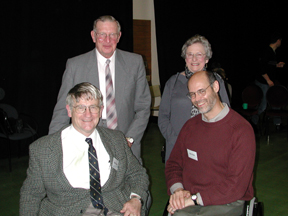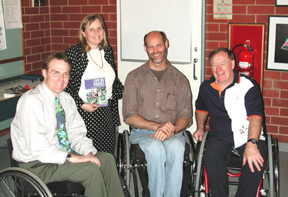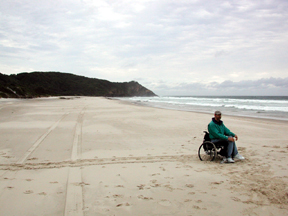 |
||||||
|
||||||||||||||||||||||
|
A brief journal from Down Under
|
||||||||||||
| I was invited by the New Zealand Spinal Trust to give the keynote "oration" at its first spinal cord conference. The three day event was held at the Burwood Spinal Unit in Christchurch, NZ, hosted by Dr. Alan Clarke, the unit's director. Dr. Clarke is also paraplegic, and was a completely delightful and generous host. He even gave me the keys to his hand-controlled Lexus after the conference so I could spend three days driving around the South Island!
My first experience driving on the left. Takes getting used to, believe me. At the conference I also gave a three hour workshop on manual wheelchairs, and a session on Sex and Disability that was so popular that it had to be moved into the main gymnasium. Dr. Clarke had arranged for me to speak at the University of Otaga in Dunedin, 5 hours south of Christchurch. |
||||||||||||
 |
||||||||||||
|
New Zealand and Australia |
||||||||||||
| Gary Karp with Dr. Alan Clarke (front left) and Dr. and Mrs. William Utley. Dr. Utley petitioned the New Zealand government to open the first spinal unit in the country. This was taken after Karp delivered the "Utley Oration" on September 16, 2000 at the opening night of the spinal cord conference "Life Beyond Bugger". | ||||||||||||
|
New Zealand is a small country of only 3.5 million people. The Burwood spinal unit is the best equipped in the country, and there is only one more in the country, in Auckland on the North Island. It is quite small, and ironically in the country's largest city.
Access in New Zealand is generally quite good, although the laws and building standards are not as strong or well developed as in the U.S. Simply for lack of numbers, there is not as substantial a disability movement as in the States. At the same time, people like Dr. Clarke are more intimately involved with government ministers, precisely because of the small population. Burwood is involved in developing voice activated computer stations for beds with recent quadriplegics. In other words, there is no lack of technology in NZ, and many of the arrangements made for my appearance happened via the internet. Access to education is one of their greatest challenges. At Dunedin, there is a disability services group that has begun to make headway on a campus which is New Zealand's first. Integration of children into public schools has yet to occur. "Kiwis" are truly exceptionally friendly people, and I discovered just how much we are affected in the States by our history of the Viet Nam and Watergate eras. Activism is much more in our blood, but countries like New Zealand and Australia - without that kind of disillusioning history and with their gentile British roots - tend not to be quite as "in your face" as we are in the U.S. It struck me as both a disadvantage and an advantage. They could stand to fight a little harder for disability rights, yet they have a way of working together that is less adversarial. The Olympics had begun during my stay in NZ, and of course their coverage was focused on the NZ team, which didn't do very well. But their news was nonetheless focused on any potential medals, and they were quite proud whenever one of their own succeeded. The Kiwis have a bit of an inferiority complex about their Australian neighbors, who have the stronger economy. They also find that Americans arrive, surprised that NZ is a country of its own! It was a good time to be in New Zealand. Not only was it the beginning of Spring (in September!), but the American dollar was very strong. They weren't pleased, of course, but it meant that as little as 40 cents U.S. got you a New Zealand dollar. I ate well. |
||||||||||||
| After two weeks in New Zealand - including meeting government disability ministers in the Capitol, Wellington, and speaking at the rehab unit in Auckland, I headed on to Melbourne, Australia.
Melbourne was much larger and more cosmopolitan than I expected. They had just completed building their new Colonial Stadium. I was scheduled to meet with advocates at Yooralla, a group that provides an array of services, similar to an independent living center. I also spoke at the Royal Talbot rehab center. My next stop was Adelaide, where I was hosted by my friend Jeff Heath and his wife, Yvonne. Jeff published Link Magazine, and has been paraplegic since he was a small boy. |
||||||||||||
 |
||||||||||||
| Gary Karp and staff members of the Hampstead Rehabilitation Center in Adelaide, South Australia, after speaking to a group of clients and families. | ||||||||||||
| Jeff had tried on a couple of occassions to get me to Adelaide to give juggling workshops and performances. At one stage he had landed a grant, but the timing was not workable for me, so I had to decline. So after years, at last I was able to visit.
Again, appearances at rehab centers, talks to local advocates, and a few radio interviews. Jeff and Yvonne put me up in their home, and made sure that I got the chance to see a Koala Bear and some Kangaroos at a local nature preserve. After a month on the road, the next portion of my trip was planned as pure vacation, knowing that I would be finishing up working as a reporter and photographer at the Sydney 2000 Paralympic Games. I took four days in Port Douglas, in the northeast of the country. It's a beach community, and I took a day trip out to the Great Barrier Reef where I snorkeled. On another day I took the 7.5 kilometer Skyrail tram over the rainforest just north of Cairns. |
||||||||||||
| From there I visited Byron Bay, 3 hours south of Brisbane, and stayed at the Rainforest Inn. It was originally named The Wheelers Inn, and was built by an American woman with her settlement money from a spinal cord injury. Soon she had a partner in Catherine Carter, also with SCI, who is now the sole owner and operator. I had a cabin to myself tucked in the woods, totally crashed for the first two days I was there, and then got out to tour around the area. I met an American man married to an Australian woman who took me out onto the beach, and got me fantasizing about living in the land down under.
From there it was on to Sydney for the Paralympics, where I stayed at Darling Harbour, a half hour from where the games took place in Homebush Bay, a suburb. |
||||||||||||
 |
||||||||||||
| On the beach at Byron Bay, Australia. | ||||||||||||
| I had commitments to write for New Mobility magazine (thearticle is to appear in the January, 2001 issue), and upload photographs for their web site. I also wrote for WeMedia.com, who had a team of 300 people doing live coverage online, the first time this has ever been done at any sporting event.
I have not been a regular follower of disability sports. As I was leaving the States, I made a point to emphasize to people that the Paralympics was a true, world class sporting event, but even I was surprised by the caliber of the sport. The Games were a lot of fun, extremely well organized and managed, with the same level of official oversight as the able-bodied Games. The Australians were expecting a total of 650,000 to attend. They got 1.1 million, including selling out the Opening and Closing Ceremonies to 110,000 people each. More to the point, the devotion and competitiveness of the athletes - 4,000 of them from 127 countries - was as total as the Olympic athletes. When it came down to it, the disability really was not what mattered. It was good sport, played by people who worked extremely hard to get there, and gave every ounce of effort to do their best. And the Australians - who are serious sports fans, and very happy to have their party carry on for another round - got the message loud and clear. They made Sydney 2000 the most successful Paralympic Games. So, check out the pics! |
||||||||||||